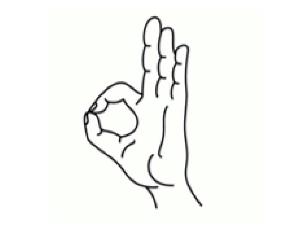Топольницька О.О. The difference between understanding gestures in the process of international communication
Матеріал з PSYH.KIEV.UA -- Вісник психології і соціальної педагогіки
Топольницька Ольга Олегівна – студентка Педагогічного інституту Київського університету імені Бориса Грінченка, напрям підготовки «Початкова освіта», кафедра іноземних мов і методик їх навчання Київського університету імені Бориса Грінченка
Стаття присвячена проблемі відмінності між розумінням жестів в процесі міжнародного спілкування. Розглянуто невербальну комунікацію як елемент, який робить можливим зрозуміти справжні почуття і думки. Викладена важливість знання і розуміння значення найбільш поширених жестів у різних країнах.
Ключові слова: невербальна комунікація, вербальна комунікація, міжнародний зв'язок, жести різних країн.
Статья посвящена проблеме различия между пониманием жестов в процессе международного общения. Рассмотрено невербальную коммуникацию как элемент, который делает возможным понять истинные чувства и мысли. Изложено важность знания и понимание значения наиболее распространенных жестов в разных странах.
Ключевые слова: невербальная коммуникация, вербальная коммуникация, международная связь, жесты разных стран.
The article is devoted to the problem of the difference between understanding gestures in the process of international communication. Non-verbal communication as an element which make it possible to understand the true feelings and thoughts.The importance of knowing and understanding the significance of the most common gestures in different countries.
Key words: non-verbal communication, verbal communication, international communication, gestures in different countries.
Зміст |
Problem definition
According to view, for the person as a social creature one of the most important needs is a requirement in a communication. People talk to each other through verbal (word) communication, in order to make language more interesting for the listener, widely used non-verbal communication. E.A Podolski established, that by verbal (word) communication passed only 7% of information; due to voice facilities (including tone of voice, intonation sound) - 38%, non-verbal communication - 55% [8].
Traditionally non-verbal communication is determined as a system of signs that is used in the process of commonunication and differ from a language by facilities and form of exposure.
Analysis of recent research and publications
Today a lot of theoretical and experimental works of native and foreign researchers are devoted to the international communication. Among those investigations we should mention the works of E. Gall, C. Klakhon, A. Kroeber, R. Porter, D. Traher, T. Komarnytska but it should be noted that to attention mostly accept a verbal component (I. Beht, T. van Dijk, I. Ivanov, A. Issers, A. Kamensky, A. Selivanov, etc.), which for today is more structured and studied.
Charlie Chaplin and other actors of silent movies were the founders of nonverbal communication, for them it was the only way of communication on the screen. Each actor was classed as good or bad. When the sound films have become popular and have less focus on non-verbal aspects of acting, many silent film actors left the stage and the screen became prevail actors with strong verbal abilities.
The most influential work in the sphere of non-verbal communication is the work of Charles Darwin "Expression of the Emotions in humans and in animals" published in 1872. It has stimulated current research in the field of "body language" and many of his ideas and observations are recognized today by researchers all over the world. With that time scientists have detected and recorded more than 1,000 non-verbal signs and signals [8].
Professor Berdvissl done similar studies on the proportion of nonverbal means in communication. He found that the average person speaks words only for 10-11 minutes a day, and that every sentence in the middle sounds no more than 2.5 seconds.
Most researchers agree that the verbal communication is used to transmit information, while non-verbal communication is used for "discussion" of interpersonal relationships, and in some cases is used instead of verbal messages.
Formulation of the aim of the article
Non-verbal communication is very important at this stage of our society, because it’s not only duplicate, reinforce or replace verbal communication, but also confirm or deny the information that complement the content of expression, particularly emphasize important points of communication, control and regulate the process, make it possible to understand true feelings and thoughts of interlocutor. But we must remember that non-verbal communication is like language - unique and characterized among different peoples and different countries.
For extensive coverage of the characteristics of non-verbal intercultural communication is important to consider gestures and their relation to verbal communication. Rather than say "yes" or "accept", you can nod your head. Rather than say "hello", you can reach out or bend your head. When you need to emphasize an opinion, you pick up your index finger. Forefinger you threaten playfully child, and this gesture completely replaces the order "Stop!". Thus, we can say that language of gestures (at least in its function) equivalent verbal language, but unfortunately, not everyone understands that sign language is not universal language. Transferring gesture symbols adopted in the our culture to another leads to difficulty in communication.
The aim of our research is to characterize the difference between understanding non-verbal communication in the process of international communication.
The main research material
Non-verbal communication, although it belongs to the norms of behavior in a particular culture, can significantly affect the communication. Knowledge of its characteristics in culture interlocutor will prevent possible embarrassment. For example, typical gestures (such as “all right”, raised thumbs, V-shaped gesture of fingers etc.) in national cultures interpret differently. Most gestures of nonverbal behavior are acquired and the value of many gestures caused by culture.
The American researcher of non-verbal communication Alan Pease assures that feature of the non- verbal communication is that it’s caused by expression of the human subconscious impulses, and that cannot be faked, enables us to trust this language more than usual channel of communication [3].
Nonverbal messages can have a huge effect. But surely the palm of victory in this case belongs to the gestures. Word «gesture» in the dictionary has few meanings: it’s a movement or position of the hand, arm, body, head, or face that is expressive of an idea, opinion, emotion; any action, courtesy, communication, etc., intended for effect or as a formality; considered expression; demonstration and the use of such movements to express thought, emotion [1].
Gestures known since ancient times, that was prevalent as early as primitive people all over the world. Koni in "Advices to the lecturers" wrote: "Gestures recover speech, but they should use caution. Expressive gesture must match of content and meaning of this phrase or a single word" [3].
Today we understand that when people are happy, they smile when they are sad - they frown. But the smile was originally a symbol of the threat, the man smiled wickedly when attacking the enemy, but today, in conjunction with friendly gestures, it denotes pleasure or goodwill.
Gestures can be universal, that is characterized of speakers of any language, regardless of race or culture, or ethno-specific when nonverbal behavior is one but has different values in different communicative situations of different nations. That is, a single gesture can have a certain interpretation of a single nation, and it can be quite differently interpreted other nation.
Gesture "shrug" is a good example of the universal gesture that indicates that the person does not know or does not understand what someone mean. This is a complex gesture, consisting of three components:
• open palms;
• raised shoulders:
• raised eyebrows.
At that time, when particular gesture may be recognized and have a clear interpretation in one nation, it may not have any notation or be completely opposite in another nation. For example, consider the difference in the interpretation of four typical gestures in different nations: raised thumb, «all right» gesture, the «V» sign and «come here» gesture.
Raised thumb. When you thumb up your finger you think it means: "It's all good!" and in many countries like Ukraine, USA, UK, Australia, Canada it’s a sign of approval but in Thailand it means serious side-eye. Some say it's very offensive, while others contend it's more childish than obscene. A thumbs up in any Muslim country means, loosely translated, that you hope the person you're gesturing at has a very pleasant trip to the proctologist.
«All right» gesture. This gesture is well known in all English-speaking countries, Europe and Asia. It means that everything is hunky-dory. But in France it means "zero" or "nothing", in Japan - "money", in some countries of the Mediterranean it means something very different that belong to the homosexuality.
The «V» sign. This sign with your fingers popular in the UK, Australia and has touchy interpretation - "shut up", if a hand is reverse a palm to that, who talks. If a hand is reverse a backside to that, who talks, then it means "victory". However, V gesture in any case means "victory", so if the Englishman wants this gesture to tell the Europeans to shut him up, the Europeans won’t understand him. In many countries, this gesture means the number "2".
This «come here» gesture (curling pointer finger forward and motioning repeatedly) is very popular in Ukraine and means someone to come to you. In Philippines it’s considered to be a gesture befitting only usage on a dog and is punishable with jail time if used on a person. So, you can be arrested for showing it.
These examples suggest that, to some misunderstandings can cause misinterpretations of gestures, do not take into account the national characteristics of the speaker. So, before you make any conclusions about the meaning of gestures and body language, it is necessary to consider the nationality of the person [3].
Conclusions
Summing the above, we can conclude that non-verbal communication in intercultural communication occupies a very important place. Non-verbal means of intercultural communication make it possible to understand the true feelings and thoughts of foreign interlocutor.
Research in the field of linguistics has shown that there is a direct
relationship between social status, power and prestige of man and his vocabulary. In other words, the higher social or professional position, the better its ability to communicate at the level of words and phrases. But is there a connection between social position, level of verbal communication, prestige of profession, nationality and the number of gestures and body movements, which someone enjoys? This issue we will consider in our next work.
According to social surveys, the level of trust to words of people is 20%, and non-verbal - 30%. Moreover, non-verbal communication make it possible to know the person shape our attitude towards it.
Thus, it is important to know and understand the significance of the most common gestures in different countries, which may help you in a difficult situation or help avoid it. Therefore, traveling to different countries, you should obey the rules "with own charter in another monastery do not go". This will help you avoid potential embarrassing situations.
References
- Longman. Active Study Dictionary. – UK: Pearson, 2004.- Pp. 311
- E.A Podolskaya. Philosophy: textbook. - K .: The company "Inkos" Center of textbooks, 2006. – Pp. 554-556.
- A. Pease. Body Language. - Nizhniy Novgorod, 1992. - Pp. 5-12.



